Settlers IV Preview
We take a look at the next installment of Blue Byte's long-running city-building series.
Settlers is a venerable real-time strategy series that has a considerable following. Developed by Blue Byte software, it puts a tribe of developing people in your hands and asks you to shepherd them from a mob with resources to a bustling community. The games are often specific in scope, and look like cartoonish versions of the other real-time strategy games on the market. Over the years, the Settlers series has come to play very much like the 'Craft or Command & Conquer games, but it has always emphasized complex economic interdependencies over combat. It's a different kind of game from the Tiberian Suns and Starcrafts, which people are used to playing. But different isn't bad. And in an environment where RTS games are moving toward more tactical combat, Settlers IV, the newest iteration of the series, is going the opposite route. It's definitely a game about resources and base building. But realizing that the current market is also looking for exciting tactical combat, Blue Byte has continually been adding more combat elements into the series. Does this latest version of Settlers successfully provide the best of both worlds? Engrossing tactics and challenging economics? Let's find out.
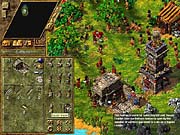
In Settlers IV's storyline, a dark angel has angered the gods and has been banished to the earth. Accompanied by his sultry female assistant and a contingent of his dark minions, this angel called Morbus, has decided to remake the world into a more comfortable living place. Since Morbus is physically pained by beauty and order, he has no choice but to defile the very earth itself and turn the entire planet into a wasteland. Using corrupting plants that leech all life out of the soil and blacken the earth, he has defiled the land.
Meanwhile, in the part of the world that has yet to feel Morbus' creeping evil, several nascent human tribes are battling each other and are trying to turn themselves into thriving civilizations. There are three such tribes, and these are the playable races in the game. Settlers fans hoping for a return of the female Amazons will be disappointed. There are the Romans, who return from Settlers III, as well as the Mayans and the Vikings.
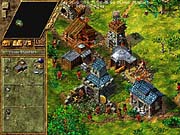
The three races play similarly, with only a few differences in resource requirements and a unique unit each, but they and their buildings look different. The Viking settlers are potbellied bearded men, while the Romans wear togas and short-cropped hair. The Mayans are bare-chested and dark-haired, and they use more stone in their building, while the other two races use more wood.
Each has its own minicampaign consisting of three missions each. The mission objectives are very straightforward. Those who criticized the previous games in the Settlers series for having monotonous missions where you just beat on the competition will find that the missions appear to be the same for the most part. Most missions for all sides boil down to destroying whoever is on the same island or continent with you. After going through each of the minicampaigns there is a longer final campaign, wherein you take on Morbus and his Dark Tribe. Morbus has poisoned the earth, and you must wipe out his forces and then recultivate the barren landscape so you can build on it again.
First Impressions
Fans of the series will notice that Settlers IV has evolutionary, not revolutionary, changes. The game is iterative in its changes and enhancements. Newcomers will find the graphics livelier than other RTS games and the characters and buildings more cartoonlike. Veterans will find that the graphics are now more detailed. The characters are also bigger.
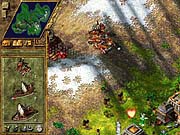
In fact, all the objects are larger and more detailed, so you can really see your world at work. When resources are used to build a building, you'll actually see your settlers carrying the planks of wood and blocks of stone to the building site. You'll see the workers leveling the land prior to building. Each resource created, from sacks of unrefined iron to the smelted bars, is depicted on the screen individually. This means there is a visual representation to every resource in the gameworld. Certain mines, for example, need to be stocked with food to keep the miners inside happy and productive. Your settlers will drop off this item near the mine. Because each loaf of bread or haunch of meat is visually depicted on screen, you won't need to click on the building to find out that the mine is slowing in productivity because the miners ran out of bread. You can just look near the mine and find that the stack of bread has gone from seven loaves to one. This visual feedback is subtle but everywhere once you start looking, and for someone new to the series, it's fascinating.
The animation for the characters is clean and fluid and looks better than that in Age of Empires II. You'll see a smelter, for example, pick up that sack of iron, bring it into his smelting factory, and then see the newly minted iron bar slide out from the foundry before he picks it up and puts in it a neat stack by his factory. Then you'll see a settler swoop in and pick it up to bring to the weaponsmith's hut.
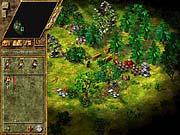
Although the graphics and animation of this game are easy to appreciate, the gameplay, frankly, isn't. The game itself is fun and complex, but it isn't easy to get into -at least not in the build we had when we were writing our preview. Admittedly, the game is still in development, and, judging from the state of this build, still several months from release, but the game does seem to be complex and sometimes not very intuitive. Although the eventual payoff might be good, gamers won't suffer a poor interface or want to slog through a brow-furrowing first few hours. Our beta build did not have a tutorial, but Blue Byte promises that the tutorial in the game will be easy and will gradually introduce gamers to the game. There is tooltip help with the interface, but there is just so much to absorb and know when starting out that the game could be overwhelming or confusing to newcomers for the first few hours of play.
The interface has been reworked to be more intuitive, using slider bars instead of percentages for allocating settler professions, for example. It makes basic commands easier, but it provides little help or information for more complex questions, such as how to build squad leaders or how to supply water to your various buildings. We figured out those issues after a few tries, but it's far from the ease-of-use that Blue Byte is shooting for. Hopefully, the final version will alleviate these concerns, especially with the tutorial.
The Unresponsive Settler
Settlers IV is a game about interdependencies. The resource model and tech tree are all tied together. You don't just lay down barracks and start cranking out units. This game isn't that simple. First, let's talk about the settlers themselves.
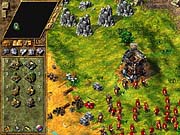
You can't actually control your settlers. You can't click on them or order them about. Instead, you can only control them indirectly. The computer knows what to do with them, but you have to nudge it along by giving your settlers something to do. Once you lay down the outline for a mine, for example, the minimum number of settlers needed to build it hop to work. A few settlers will go to the site and start leveling the ground. Then carriers will bring over the necessary resources to construct the building. Finally the builders will start constructing it once the wood planks and stone blocks are there. And when the building is done, those settlers who were mobilized to build the building will then go inert again. It's disconcerting and, in a way, not very empowering for gamers used to roping their peons and ordering them about in games like Starcraft or Age of Empires II.
The only units you can control directly are military units and special units. Both are trained from your basic, uncontrollable settlers. If you start from scratch, your beginning population will be basic settlers. You can then train some of these settlers to become gardeners, pioneers, thieves, or geologists. These four units can be clicked on and moved, but you can't actually click on an object to have them interact with it or control their actions. Rather, in the case of the miner, you click on him, click on the mountains, and he goes there and does his thing, which in the miner's case is nailing down signs to tell you where to build your mines. These four special units can be trained without any buildings, and initially they are your only way to explore the map. Without a pioneer, for example, to move around the map, your fog of war will never be peeled back, as you can't make your regular settlers move.
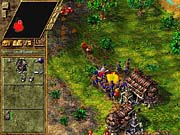
To create military units, you need to build your barracks first, and then train a swordsman or archer from the general settler population. You don't actually build a soldier, you turn an idle settler into a soldier. Pretty soon, you'll run out of settlers, especially if you have a large economy, but you can build houses of progressive sizes, which create dozens of more settlers. These too will stand around like brain-dead monkeys until you create a larger economy to employ them or turn them into controllable military units.
Although your basic settlers cannot be controlled directly, they'll start working once you build the basics of a town. For instance, once you have an iron mine, iron smelting factory, and a weaponsmith shop built, a few settlers will be employed to work in the buildings, and a few others will be employed as carriers who'll carry the unprocessed ore from the mine to the smelter and the iron bars from the smelter to the weaponsmith. However, the economy of your town will only employ the minimum number of people, so you'll often see many of your settlers standing idle, which tells you that you could be doing more.
You get the feeling that your settlers are unemployed bums, but thankfully the game's entire resource and building model is so dependent on various little parts that it can employ your idle masses.
Economy
As mentioned earlier, Settlers IV is complex, and the economy is predicated on a number of prerequisites and interdependencies. It's not different from the previous Settlers games, but, for newcomers, it bears explaining.
To build any building, you need planks of wood and stone blocks. Stone blocks are easy to build. You just lay down a stonecutter's hut, and he churns out blocks at a gradual pace. To get planks of wood, you first need to lay down a woodcutter's hut. From here, a lumberjack cuts down trees and amasses logs of wood. But to turn those logs into planks, you need to build a sawmill. Once the sawmill is built, the logs of wood are carried from the woodcutter's hut to the sawmill to be turned into planks. These are the simple resources.
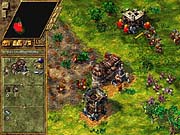
To create tools or weapons, you first need to build two mines: an iron mine to get iron ore and a coal mine to get coal, which is used in smelting the iron. Then you need to build a smelter's factory, where the ore is turned into iron bars with the help of the coal. Finally, you need to build a toolmaking works to turn the iron bars into tools or a weaponsmith works to turn the iron into weapons. To ultimately train troops, you need to build barracks. If you want to train a swordsman, you'll need to have one sword per swordsman. To train an archer, you need a bow. You can't train any soldiers until you actually have these weapons in your inventory. As illustrated, you'll need a quartet of buildings - iron mine, coal mine, smelter, and weaponsmith - to first get the weapons. Then, to train the swordsman, for example, you'll need the weapon as well as gold, which in turn requires a gold mine and a gold smelter to turn the gold into ingot currency.
However, even knowing the prerequisites for buildings and the multistep creation of resources aren't enough, because placement and your worker's range require consideration. You need to place your stonecutter's hut near stone quarries, your woodcutter's hut near trees, and your various mines of the right veins of metals. It isn't enough to place your mines on a mountain. There could be no metals underneath your mine or even the wrong metal, in which case you'll see your mine producing nothing. You'll need the geologist to tell you where the various metal veins are and then put down the appropriate mine.
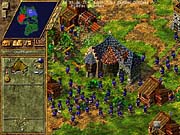
Also, you can only build a certain distance from your towers. In effect, you have a limited radius in which to build. If you run out of space and need to expand beyond your initial setting, you'll need to build towers to expand your territory, and you'll need to man them with troops before you can build beyond your initial range.
When creating a single swordsman takes six buildings and several resources, it becomes clear that the game is far from simple. But that doesn't mean Settlers IV won't be challenging and engrossing to play. Indeed, it is. Despite the fact that our build kept crashing, we kept playing. Finding ways to employ your settlers and keeping your entire economy moving takes skill and intelligence. With everything so intricately connected, just one missing piece could grind your well-honed economic machine to a halt. Keeping everything in working order and keeping all your buildings and specialized workers, such as miners, supplied is the heart of this game, and it is exciting.
But what about the supposedly improved combat? Is that portion of the game really better?
Combat and the Three Tribes
In contrast, the combat isn't nearly as complex as the base building or economy. It also isn't as deep as the combat in Age of Empires II or Starcraft. There are only four military units per side, not including transport and siege units. You just click on them and tell them to move. When they encounter enemy troops, they start fighting. There aren't any special abilities to employ, and you generally can't target specific enemy units.
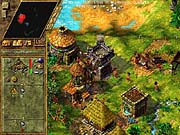
Too simplistic combat was a criticism of the previous Settlers, and a few new units have been added to spice up battles. Now, there are squad leaders who increase the battle skills of surrounding troops, such as swordsmen and archers. You'll need to construct a suit of armor to train a squad leader, but a squad leader gives you an advantage in battle. Each side can also build a siege engine, such as a catapult or a mobile cannon. These can target towers and fire from afar.
Priests can call on spells once you sacrifice alcohol to the gods, and this should make combat more interesting than in previous Settlers games. Unfortunately, we weren't able to test them out because the build we had repeatedly crashed an hour or so into each game we played. But the base building part of the game, and the setup is exciting enough that we are looking forward to getting a new build so we can test out the priests' spells.
All three sides have a unique unit, although aside from that they play very much alike. The Vikings are better melee fighters, and their unique unit is an axeman, who has more power than the swordsman but weaker defense. The Mayans go for ranged fire and have a second ranged unit in the blowgunman. The Romans can field a more resilient army with their unique unit, the medic, who can heal others in the field up to 75 percent of their total hit points. The other sides can only heal units by bringing them back to the healer's hut in town, where they can be healed to maximum hit points.
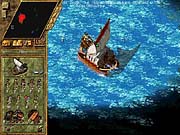
Aside from these few units, the sides also differ in that the Mayans have a gunpowder cannon instead of a catapult as their siege weapon. There is also a difference in resource dependencies - the Mayans need more stone than wood when building while Vikings need more wood than stone - but aside from these few changes the three sides play very much the same.
Although the current build of Settlers IV was very hard to get into, it proved to be engrossing once we began to understand the complexities of the resource model and base building. If the tutorial is good, then that will go a long way toward making the game more accessible to gamers. As it stands now, it could prove too complex at first try for many people. We can only wait and see how North American gamers will receive the latest incarnation of the series, which has always enjoyed more success in Europe than here. Curiously, Blue Byte is indicating that it will only sell the game in North America via its Web site rather than through retail. That release should be in a few weeks to a few months.
Got a news tip or want to contact us directly? Email news@gamespot.com
Join the conversation